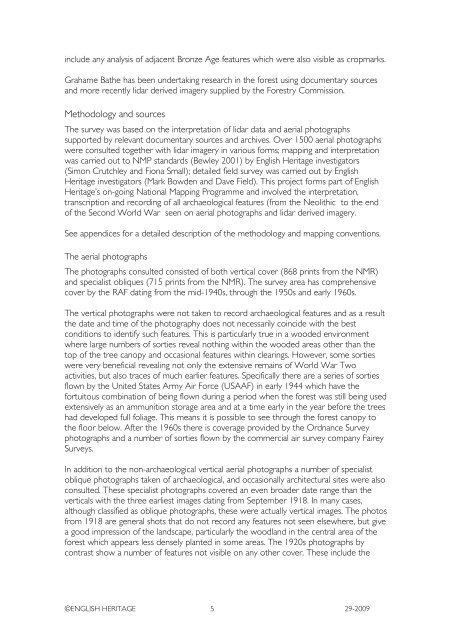savernake forest a report for the national mapping ... - English Heritage
savernake forest a report for the national mapping ... - English Heritage
savernake forest a report for the national mapping ... - English Heritage
You also want an ePaper? Increase the reach of your titles
YUMPU automatically turns print PDFs into web optimized ePapers that Google loves.
include any analysis of adjacent Bronze Age features which were also visible as cropmarks.<br />
Grahame Ba<strong>the</strong> has been undertaking research in <strong>the</strong> <strong><strong>for</strong>est</strong> using documentary sources<br />
and more recently lidar derived imagery supplied by <strong>the</strong> Forestry Commission.<br />
Methodology and sources<br />
The survey was based on <strong>the</strong> interpretation of lidar data and aerial photographs<br />
supported by relevant documentary sources and archives. Over 1500 aerial photographs<br />
were consulted toge<strong>the</strong>r with lidar imagery in various <strong>for</strong>ms; <strong>mapping</strong> and interpretation<br />
was carried out to NMP standards (Bewley 2001) by <strong>English</strong> <strong>Heritage</strong> investigators<br />
(Simon Crutchley and Fiona Small); detailed field survey was carried out by <strong>English</strong><br />
<strong>Heritage</strong> investigators (Mark Bowden and Dave Field). This project <strong>for</strong>ms part of <strong>English</strong><br />
<strong>Heritage</strong>’s on-going National Mapping Programme and involved <strong>the</strong> interpretation,<br />
transcription and recording of all archaeological features (from <strong>the</strong> Neolithic to <strong>the</strong> end<br />
of <strong>the</strong> Second World War seen on aerial photographs and lidar derived imagery.<br />
See appendices <strong>for</strong> a detailed description of <strong>the</strong> methodology and <strong>mapping</strong> conventions.<br />
The aerial photographs<br />
The photographs consulted consisted of both vertical cover (868 prints from <strong>the</strong> NMR)<br />
and specialist obliques (715 prints from <strong>the</strong> NMR). The survey area has comprehensive<br />
cover by <strong>the</strong> RAF dating from <strong>the</strong> mid-1940s, through <strong>the</strong> 1950s and early 1960s.<br />
The vertical photographs were not taken to record archaeological features and as a result<br />
<strong>the</strong> date and time of <strong>the</strong> photography does not necessarily coincide with <strong>the</strong> best<br />
conditions to identify such features. This is particularly true in a wooded environment<br />
where large numbers of sorties reveal nothing within <strong>the</strong> wooded areas o<strong>the</strong>r than <strong>the</strong><br />
top of <strong>the</strong> tree canopy and occasional features within clearings. However, some sorties<br />
were very beneficial revealing not only <strong>the</strong> extensive remains of World War Two<br />
activities, but also traces of much earlier features. Specifically <strong>the</strong>re are a series of sorties<br />
flown by <strong>the</strong> United States Army Air Force (USAAF) in early 1944 which have <strong>the</strong><br />
<strong>for</strong>tuitous combination of being flown during a period when <strong>the</strong> <strong><strong>for</strong>est</strong> was still being used<br />
extensively as an ammunition storage area and at a time early in <strong>the</strong> year be<strong>for</strong>e <strong>the</strong> trees<br />
had developed full foliage. This means it is possible to see through <strong>the</strong> <strong><strong>for</strong>est</strong> canopy to<br />
<strong>the</strong> floor below. After <strong>the</strong> 1960s <strong>the</strong>re is coverage provided by <strong>the</strong> Ordnance Survey<br />
photographs and a number of sorties flown by <strong>the</strong> commercial air survey company Fairey<br />
Surveys.<br />
In addition to <strong>the</strong> non-archaeological vertical aerial photographs a number of specialist<br />
oblique photographs taken of archaeological, and occasionally architectural sites were also<br />
consulted. These specialist photographs covered an even broader date range than <strong>the</strong><br />
verticals with <strong>the</strong> three earliest images dating from September 1918. In many cases,<br />
although classified as oblique photographs, <strong>the</strong>se were actually vertical images. The photos<br />
from 1918 are general shots that do not record any features not seen elsewhere, but give<br />
a good impression of <strong>the</strong> landscape, particularly <strong>the</strong> woodland in <strong>the</strong> central area of <strong>the</strong><br />
<strong><strong>for</strong>est</strong> which appears less densely planted in some areas. The 1920s photographs by<br />
contrast show a number of features not visible on any o<strong>the</strong>r cover. These include <strong>the</strong><br />
©ENGLISH HERITAGE 5 29-2009

















